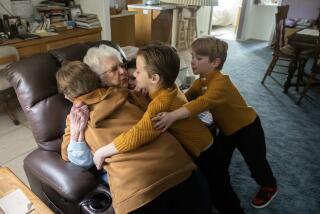Disabled Students Flock to Cockatiel
- Share via
It was an even bet who was more nervous: Boogie, the 10-week-old cockatiel, or Eric, a 20-year-old student with autism.
Nose to beak, they stared at each other until ruffled feathers folded smoothly and a huge grin crept over Eric’s face.
“[Eric] is a little shy, but he loves it when the bird comes near him,” said Nan Coppolella, who runs a program for severely developmentally disabled adults at Saddleback Community Enterprises in Mission Viejo. The nonprofit organization provides job training and education to developmentally disabled people in South County.
In a classroom where most can’t speak and progress is measured by the inch, each student has found some way of showing affection for Boogie, who became their permanent mascot two weeks ago. (Due to the severe nature of the students’ disabilities, some families declined to let their last names be used.)
Jose stares and smiles and is one of the only students to muster up enough courage to actually touch Boogie. Karen moves her wheelchair close to the cockatiel and makes high-pitched sounds of delight. When Boogie chirps, Christi, a music lover, goes into a little dance around his cage.
“We just hope Boogie will be like a personal pet for all of them,” Coppolella said. “He brings out emotion, and with a lot of our guys being autistic, tapping into their emotions is important.”
The group helped raise the $110 needed to buy Boogie by making Valentine’s Day treats and selling them to other teachers and students at the center, which provides job training to about 250 developmentally disabled adults.
Boogie helps administer pet therapy, an increasingly popular method of reaching out to people with brain damage, whether it be from Alzheimer’s disease or the result of an accident.
So far, Boogie has been the only outside stimulus to get a reaction from Ronald, a 28-year-old autistic man.
“Ron went up to the cage and actually looked at the bird,” Coppolella said.
“I know that sounds trivial, but it’s a big step. Ron isn’t interested in anything.”
But where most students see the animal just during a brief visit, Boogie is a permanent resident in the classroom, leaving only on weekends when the building is empty.
About five or six times a day, Boogie is brought out of his cage to interact with students. Class instructors are teaching the baby cockatiel a few basic words like “baby” and “hola.”
“We’re trying to get [the students] to learn these words” along with Boogie, Coppolella said. “We’re just hoping they’ll love him and make him part of their lives.”
More to Read
Sign up for Essential California
The most important California stories and recommendations in your inbox every morning.
You may occasionally receive promotional content from the Los Angeles Times.










